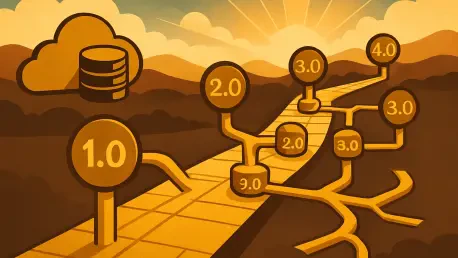In the fast-paced realm of platform engineering, a staggering reality emerges: nearly 70% of developer teams report disruptions during platform upgrades, often due to poorly managed transitions. This statistic underscores a critical challenge in modern DevOps and cloud-native environments—how to evolve standardized workflows, known as golden paths, without derailing productivity. Golden paths, as optimized templates for development processes, are pivotal in streamlining operations, yet their evolution demands meticulous versioning to prevent chaos.
This review delves into the technology of golden path versioning, a practice that promises to harmonize innovation with stability. By examining its core mechanisms, real-world impact, and future potential, the analysis aims to uncover how this approach can transform platform updates from a source of friction into a seamless enhancer of developer experience. The focus is on balancing governance with agility in an era where rapid technological change is the norm.
Unpacking the Features of Golden Path Versioning
Semantic Versioning as a Foundation
At the heart of golden path versioning lies semantic versioning, a structured approach using formats like v1.x or v2.x to signal the nature of changes. This system distinguishes between minor updates, such as patches that ensure safe, automated rollouts, and major releases that introduce breaking changes requiring deliberate opt-in by teams. Such clarity minimizes confusion and enables automation tools to handle upgrades with precision.
The significance of this feature extends to maintaining trust across development teams. When patch updates are rolled out, developers can proceed with confidence, knowing their workflows remain intact. Conversely, major version jumps are flagged as significant shifts, allowing for planned transitions rather than unexpected disruptions, thus fostering a predictable environment for platform evolution.
Facilitating Transitions with Parallel Paths
Another key feature is the use of parallel onboarding paths, where multiple versions of a golden path coexist temporarily. This strategy mitigates the stress of immediate upgrades by allowing teams to transition at their own pace. Developer portals, such as Backstage, enhance this process by offering intuitive interfaces for version selection, reducing friction during adoption.
This flexibility proves invaluable in large organizations with diverse team needs. By maintaining legacy versions alongside newer ones, platform engineers ensure that critical workloads are not jeopardized while still encouraging the adoption of improved templates. The result is a smoother journey toward modernization without sacrificing operational continuity.
Automation and Drift Detection Capabilities
Automation stands as a cornerstone of effective golden path versioning, with tools like notifications and dashboards keeping teams informed about outdated configurations. Drift detection pipelines further bolster this by scanning for discrepancies between current setups and recommended versions. Metadata tagging and automated pull requests streamline the upgrade process, ensuring visibility without blocking progress.
The power of these automated systems lies in their ability to preempt issues before they escalate. By proactively identifying teams using deprecated templates, platform engineers can target support efforts efficiently. This proactive stance not only saves time but also reinforces a culture of consistency across sprawling development ecosystems.
Performance in Real-World Scenarios
Practical Implementations Across Industries
Golden path versioning demonstrates its value in tangible applications, such as the deployment of updated Terraform modules or enhancements to CI/CD pipelines. In multi-team settings, gradual rollouts and pilot testing have proven effective in ensuring seamless adoption. These controlled implementations allow for feedback loops that refine the process before full-scale deployment.
A notable example comes from IBM Cloud, where versioning facilitated secure Kubernetes cluster updates. By introducing automated compliance controls in a new version, the platform team enabled development teams to adopt enhancements without disrupting existing workflows. This case highlights how versioning can bridge the gap between security imperatives and operational stability.
Metrics of Success and Developer Impact
Performance metrics further validate the efficacy of golden path versioning, with adoption rates, upgrade completion times, and deployment success rates serving as key indicators. Developer satisfaction scores, often gathered through surveys, provide qualitative insights into the experience of navigating version transitions. These data points guide platform teams in fine-tuning their strategies.
Beyond numbers, the real impact is seen in reduced developer fatigue. When upgrades are predictable and supported by clear communication, teams can focus on innovation rather than troubleshooting. This balance of performance and user experience underscores why versioning is becoming a standard in platform engineering practices.
Challenges Impacting Effectiveness
Navigating Common Pitfalls
Despite its strengths, golden path versioning is not without hurdles. Silent breaking changes, often buried in minor updates, can catch teams off guard, while large-scale migrations risk overwhelming developers with simultaneous overhauls. Outdated documentation adds another layer of friction, forcing reliance on informal channels for clarity.
Additionally, striking a balance between frequent updates and stability remains a persistent challenge. Too many changes can lead to configuration drift or developer exhaustion, while infrequent updates may leave systems vulnerable or outdated. These issues highlight the need for robust strategies to address potential disruptions.
Mitigation Efforts and Best Practices
Efforts to overcome these limitations include establishing clear deprecation policies and providing rollback options to safeguard against failed upgrades. Warning windows before enforcement of new versions give teams adequate preparation time. Such measures aim to maintain trust and ensure that versioning serves as an enabler rather than a barrier to progress.
Concluding Insights and Next Steps
Reflecting on this review, golden path versioning emerges as a vital tool in platform engineering, adeptly blending innovation with the need for stability. Its structured approach through semantic versioning, parallel paths, and automation delivers measurable benefits, as evidenced by real-world applications and performance metrics. Challenges like breaking changes and update frequency persist, yet mitigation strategies show promise in addressing these concerns.
Looking ahead, platform teams should prioritize enhancing automation tools to further simplify version transitions, integrating telemetry for data-driven decisions. Investing in developer-centric communication, akin to product marketing, proves essential in driving adoption. As the landscape evolves, adopting AI-driven insights to tailor versioning strategies could redefine how golden paths adapt, ensuring they remain dynamic assets that empower teams without imposing undue burden.









